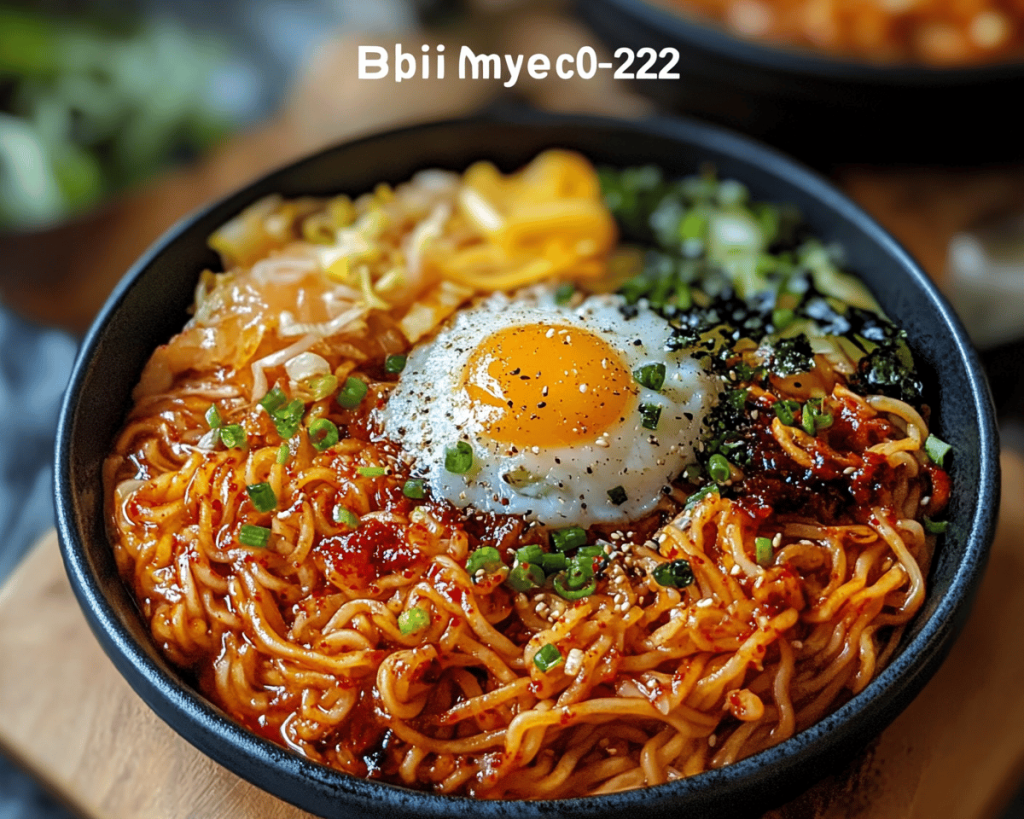You know, every dish that holds a special place in my heart usually comes with some great stories—and the beloved Bibimmyeon is no exception. Imagine a busy summer afternoon, the sun beaming down, and I find myself craving something refreshing, something a bit different. That’s when I first tried Bibimmyeon; this chilled Korean noodle dish burst onto the scene like the best unexpected guest at a party. Let me tell you, I was hooked.
The beauty of Bibimmyeon lies not just in its vibrant colors and flavors, but in the way it offers a taste of summer and a slice of Korean comfort food all at once. Each time I twirl those slippery noodles around my chopsticks, memories of happy gatherings with friends and family come flooding back. Honestly, there’s something about mixing the noodles with that spicy-sweet gochujang sauce that feels like a warm hug, even when it’s 90 degrees outside. And let’s not forget how easy it is to throw together, making it a go-to for busy evenings or casual get-togethers.
Now, before you roll up your sleeves, let’s dive into the details of this wonderful dish.
### What Goes Into Bibimmyeon?
Let’s chat about the ingredients. Seriously, each one has its quirks and nuances that can swing your dish from good to absolutely fabulous. Here’s what you’ll need:
– **Noodles**: Traditional Bibimmyeon uses thin wheat noodles, which are chewy and perfect for cold dishes. Honestly, I’m not picky; when I can’t find these specific noodles, I’ve used other types, and it still tastes great. Just keep it light and springy, okay?
– **Gochujang**: This fermented chili paste is the heart of the dish. It brings that sweet, spicy kick that will tantalize your tastebuds. I swear by a particular brand my friend’s mom from Busan taught me to use, but honestly, any good-quality gochujang will do!
– **Sesame oil**: A few drops of this golden elixir can elevate the dish. It adds a lovely depth and nuttiness that complements the gochujang perfectly. And don’t skimp on it; it’s like liquid magic.
– **Sugar**: Just a pinch—this helps balance the spice from the gochujang. It’s one of those “eye tests,” you know? Just a sprinkle!
– **Vegetables**: You can really go wild here! I love chopping up julienned cucumber, shredded carrots, and maybe even some bell peppers if I’m feeling extra. They add crunch and freshness.
– **Boiled egg**: Lastly, let’s talk protein. A soft-boiled egg on top gives richness, while softening the spice a bit. Plus, I mean… it just looks pretty, right?
You can easily adjust ingredients based on what’s in your fridge or your personal taste. Bowls of Bibimmyeon can turn into a little garden of whatever vibrant veggies you have lying around!
### Is Bibimmyeon Actually Good for You?
Alright, let’s get real for a second. Bibimmyeon is comfort food at its best, but let’s not pretend it’s all healthy sunshine and rainbows. The dish is relatively light, especially since we’re using fresh veggies and wheat noodles, but yes, it does come with a hit of sugar and sodium from the gochujang and sesame oil.
Still, it’s packed with nutrients from the fresh veggies, especially if you load up your bowl. You’ve got fiber, vitamins, and a good dose of protein from the egg. Honestly, it’s about balance; everything in moderation. And let’s not forget, mental and emotional health is just as important as physical health—this dish definitely lifts my spirits, so that has to count for something, right?
### Here’s What You’ll Need
– **2 servings of thin wheat noodles** (or your favorite noodle alternative)
– **2 tablespoons of gochujang**
– **1 tablespoon of sugar** (or to taste)
– **1 tablespoon of sesame oil** (plus more for drizzling)
– **1 small cucumber**, julienned
– **1 small carrot**, julienned
– **1/4 bell pepper**, julienned (optional)
– **2 soft-boiled eggs** (1 per serving)
– **Sesame seeds** for garnish
– **Green onions**, chopped for garnish (if you’ve got them!)
### How to Make Bibimmyeon Step-by-Step
1. **Start with the Noodles**: Put a pot of water on to boil and cook the noodles according to the package instructions until they’re al dente. You know, just chewy enough that they hold up against the sauce but not too firm. Drain them and rinse with cold water to stop the cooking process. Pat yourself on the back, you’ve conquered the noodle part!
2. **Mix the Sauce**: While your noodles are cooling, in a bowl, combine the **gochujang**, **sugar**, and **sesame oil**. Stir until you’ve got a smooth, slightly thick sauce. Honestly, I sometimes taste it and adjust as needed—little more sweet, little more spicy. Just go with your gut!
3. **Chop Your Veggies**: Get your veggies prepped while you’re waiting for the noodles. Honestly, this part can be fun! Put on your favorite tunes and chop away. Have fun with it! Toss those julienned cucumbers, carrots, and that optional bell pepper into a bowl.
4. **Combine**: Drain your cold noodles and toss them into a larger bowl with your sauce and veggies. Mix gently; we want those noodles coated but not mush. If it’s looking dry, drizzle a touch more sesame oil.
5. **Plate it Up**: Serve the noodles in bowls and cut the soft-boiled egg in half, placing it on top. Sprinkle some sesame seeds and chopped green onions for those beautiful pops of color and flavor!
6. **Final Touch**: Now, you can drizzle a bit more of that glorious sesame oil on top, and voilà!
### Little Extras I’ve Learned Along the Way
Okay, friends, here comes my favorite part: the little tricks and twists that’ll make your Bibimmyeon truly yours!
– **Noodle Swap**: You can use any noodles; soba or even rice noodles work wonderfully! Just remember that cooking times will differ.
– **Add Meat or Tofu**: Feeling a little extra? Try adding some sliced grilled chicken, leftover beef, or even crumbled tofu if you want a vegetarian twist. It works like a charm.
– **Spice Level**: I’ve got a cousin who dumps in extra gochugaru (Korean red pepper flakes) to turn up the heat! If you like things fiery, give it a go!
– **More Veggies**: This is your canvas, so don’t hold back! Throw in some sprouts, blanched spinach, or whatever you have on hand.
– **Make it Ahead**: The sauce can be prepped a day before and kept in the fridge—you’ll save time on a busy weekday.
The best part of cooking, at least in my experience, is the little mess-ups that turn into happy accidents. Like that one time I got too distracted chatting and let my eggs boil a bit too long—what I got was a beautifully hardened egg that was perfect for crumbling on top. A happy mistake if there ever was one!
This one means a lot to me. It’s simple yet versatile, and full of flavor; it reminds me of warm summer nights spent enjoying good food and laughter with friends. I invite you to try making Bibimmyeon—it’s a pleasure to share this with you. If you give it a whirl, I’d love to hear how it turned out or any delicious twists you added. Happy cooking!



